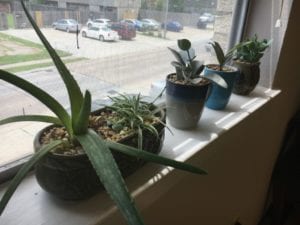When the 1988 NASA study about plants improving indoor air quality began to circulate on social media, I was happy (and adamant) to convince anyone I lived with to split the cost of plants and pottery to create a jungle inside my home. Needless to say, indoor jungles aren’t for everyone. Children and pets, in particular, can quickly morph your interior plants into an actual forest floor. Here are a few spectacular indoor plants that are hard to murder, look great, and have the added benefit of removing common household toxins from the air (though still susceptible to clumsy children and pets).

Aloe
Not only does it add interest and beauty to a window, it can withstand being ignored for months and has a plethora of uses. Aloe is used in beauty products, has antibacterial and antioxidant qualities, and is cooling on sunburns. Now is the perfect time to stock up on aloe as we’ll all be exposing our fresh from winter skin soon. There are several types of aloe with differing uses and growing needs, though only a few are available locally. To speed up the growing process of your aloe vera, put it outside in half sun during summers and bring inside during winters.
Sansevieria
There are so many varieties of sansevieria available that it is hard to pick a favorite, though what is commonly referred to as Mother-In-Law Tongue might be it. Three years ago, I started off with one small 4″ tall plant and have given tens of the babies (“pups”) as gifts and filled my home with the now 2′ tall stalks.
Palms
Palms are perfect for large spaces that are lacking a focal point, plus in the right conditions they are fast growing (meaning they are super efficient at the oxygen-carbon dioxide trade). While they should not ever dry out completely, they are still very low maintenance. They don’t need much by way of light or fertilizer and for their size, they are by far the cheapest option for indoor plants.
Spider Plant
Once in college, I forgot about two plants that I had sat on top of our kitchen cabinets for about 6 months. One was an English Ivy and the other was a spider plant that I still have today. Both of them thrived, in indirect light and no water for half a year. Not a glance in their direction. This is a great plant to be suspended from a ceiling hook or placed on a high shelf as their growth pattern will send out new plantlets that you can either let dangle or stick in a new pot for another spider plant. You will see the root starts at the bottom of each new plant.
Peace Lily
This beautiful, fragrant flower is great for empty corners that don’t have much light, as they can withstand for long amounts of time without sun, which is highly unusual.
Other notable suggestions that are always locally available and easy
Succulents such as the friendship or jade plant, Haworthia, prayer plant, string of pearls, sedums, Ponytail palm, rubber plant and the panda plant.
Tip: To keep track of a watering schedule, set a note on your phone or refrigerator to water on specific days of the month, for example: Water Sansevieria on the 1st and 15th of every month.
The NASA study regarding plants effect on indoor health can be found here.
















